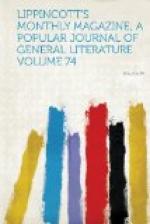The principle of the Raskol, which sometimes runs out into the wildest dreams of mysticism, is essentially realistic. Under this materialistic cultus, however, there lurks a sort of idealism, of coarse spiritualism. Religious vagaries, with all their absurdities, always have a lofty, sometimes even a sublime, side. It would be wrong to fancy that there is nothing but ignorant superstition in the Starovere’s scrupulous attachment to his ancestral worship. The vulgar heresy is, in fact, only an overdone ritualism, whose logic lands it in absurdity. The Old Believer’s reverence for the letter comes from his belief that letter and spirit are indissolubly united, and that the forms of religion are as needful as its essence. Religion is to him, both as regards forms and dogmas, a whole, all whose parts hang together; and no human hand can touch this masterpiece of Providence without blemishing it. There is an occult sense in every word and in every rite. He cannot believe that any ceremony or formula of the Church is void of meaning or of efficacy. Divine service has nothing in it merely accessory, indifferent or unmeaning. Holy things are holy throughout: in the worship of the Lord everything is deep and full of mystery; and it is blasphemy to change anything or to withhold from it its proper veneration. The Starovere, of course, cannot formulate his doctrine, but if he could, religion would appear, according to his view, a sort of completed and adequate representation of the supernatural world. His simple logic exacts from all public worship an absolute perfection which it is impossible to realize. Looked at in this light, the Old Believer who marched to the stake for the sign of the cross, and sacrificed his tongue rather than chant another Hallelujah, grows highly respectable. From this standing-point the Russian schism is essentially religious: its mistake, so to speak, is the excess of religion. Symbolism is the principle of its formalism, or rather the Raskol is symbolism run into a heresy. This gives it originality and value in sectarian history. To these extravagant ritualists ceremonies are not simply the garb of religion: they are its flesh and blood, in whose absence dogma is but a lifeless skeleton. Thus, the Raskol is the direct opposite of ordinary Protestantism, which by its very nature sets small store by outward ceremonies, regarding them as needless ornament or a dangerous superfluity. Ritual to the Starovere is as much an integral part of traditional Christianity as doctrine: it, is equally the legacy of Christ




